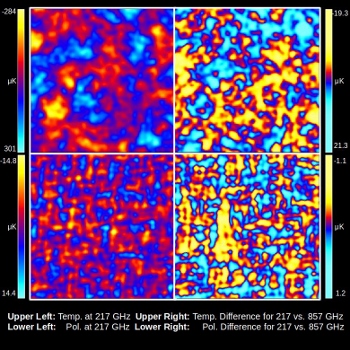Cosmic Rayleigh Scattering research highlighted by Physical Review
UBC theoretical cosmology graduate student Elham Alipour’s paper Effects of Rayleigh scattering on the CMB and cosmic structure has been selected as an Editor’s Suggestion in Physical Review D for its “novel insight on the effect of Rayleigh scattering on cosmological power spectra.” This distinction is reserved for a small number of papers deemed to be of particular interest, importance, or clarity. 
While not everyone is familiar with the remarkable science of Nobel prize winning British physicist Lord Rayleigh most of us experience his scientific namesake each and every sunny day. Rayleigh scattering is actually the same process that makes the sky appear blue. As sunlight shines through the atmosphere, the photons are scattered by the atmosphere’s molecules. This form of scattering is dependent on the wavelength of the light and results in the shorter wavelengths (the blue end of the visible spectrum) of sunlight being enhanced, thus giving us the perception that the sky is blue. (Find out more about what makes the sky blue at Hyperphysics)
Elham, working with UBC Professor Kris Sigurdson and Ohio State University researcher Professor Christopher Hirata, wanted to look more closely at the effect this scattering has not on the light from our sun, but rather on the cosmic microwave background (CMB). CMB is recognized as oldest “light” in the universe and originates from the time the electrons combined with protons to form the first atoms. These primordial atoms were also the first to Rayleigh scatter light. Past studies into CMB anisotropies - the small temperature fluctuations in the CMB - typically take into account Thompson scattering (the scattering of photons from free electrons); but in an effort to simplify analysis usually ignore the way that photons also couple to neutral hydrogen and helium through Rayleigh scattering. Given the exquisite measurements of the CMB that now exist, Elham wanted to reconsider the impact that Rayleigh scattering has on the structure of the CMB, quantify its effects, and find potential ways to detect it in the future. After following these lines in inquiry, she was able to precisely calculate the effect of Rayleigh scattering on CMB temperature, polarization anisotropies and cosmic structure, and found a new technique to describe and perhaps detect the Rayleigh signal in the CMB.

This research shows the CMB provides us with an additional opportunity to both learn more about and verify our understanding of the origins of our Universe. The detection of the Rayleigh signal is a significant challenge due to the low number of CMB photons found at high frequencies and the way that the signal is contaminated by multiple foregrounds before it reaches us on Earth. However Elham and her collaborators were able to show that due to the difference in spectral shape and power spectra of the Rayleigh sky between different foregrounds, if many high frequency channels are used to observe the CMB (or observations are focused on low-foreground regions of the sky), then the Rayleigh signal can be more precisely isolated. This means that in the future, scientists might be able to use these method to better pinpoint cosmological parameters such as the primordial helium fraction and the scalar spectral index from inflation, and maybe even constrain or measure the physical properties of dark matter far more precisely than was ever thought possible before.
Elham’s experiences working on this project were enhanced by the unique chance she had to engage with UBC Physics and Astronomy’s experimental cosmologists. Beyond guidance and support from her research supervisor Kris Sigurdson, she says she benefited from the helpful discussions she was able to have with Mark Halpern, Gary Hinshaw*, and Douglas Scott** about the details of CMB experiments while organizing the results of her research into this paper.
*Drs. Mark Halpern and Gary Hinshaw are members of the NASA WMAP (Wilkinson Microwave Anisotropy Probe) team, who study the properties of our Universe using CMB data from the Probe. The team received the prestigious Gruber Foundation Cosmology Prize in 2012 “for their exquisite measurements of anisotropies in the relic radiation from the Big Bang---the Cosmic Microwave Background.”
**Dr. Douglas Scott leads the Canadian Low Frequency Instrument team team for European Space Agency’s Planck Space Telescope. Planck has been generating data on the fluctuations of the CMB in order for us to learn about our Universe – its structure, properties, and history – with great accuracy.
Article by Christie Waltham and Theresa Liao.